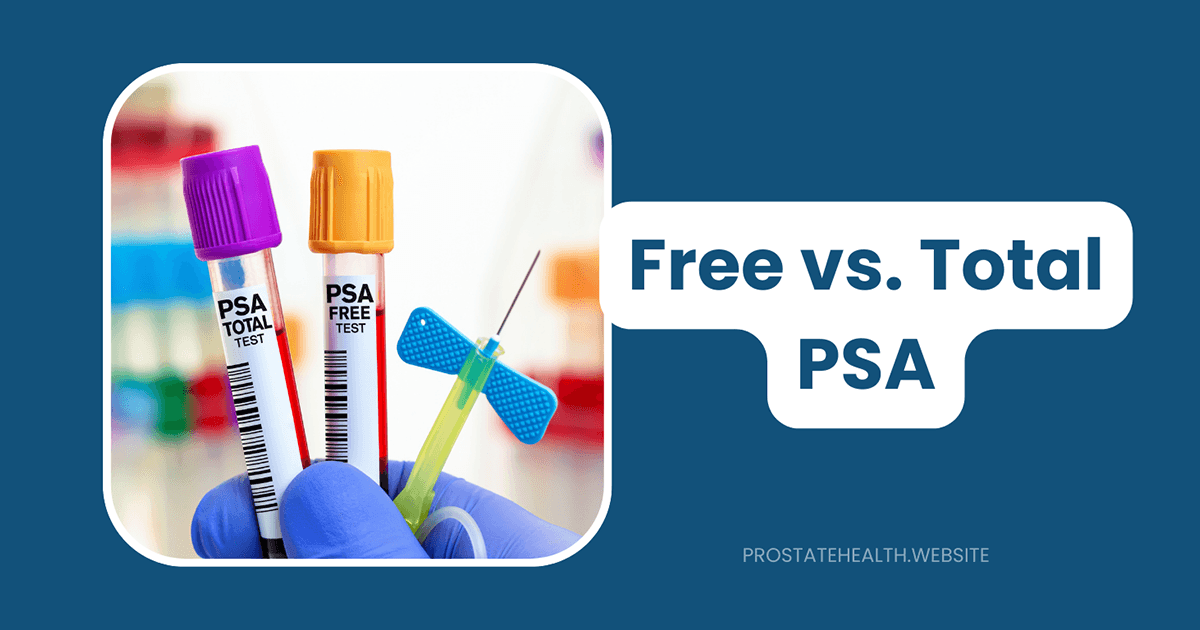Free vs. Total PSA: Understanding the Difference

When my PSA test came back at 5.2 ng/mL, my doctor immediately recommended a biopsy. Anxious and confused, I sought a second opinion. The new urologist suggested something I hadn’t heard of before: a free PSA test. “Before we rush to a biopsy,” he explained, “let’s get more information about what’s happening with your prostate.”
That decision potentially saved me from an unnecessary procedure. My free-to-total PSA ratio came back at 28%—suggesting my elevated PSA was more likely due to benign prostate enlargement than cancer. Six years later, with careful monitoring, I’ve avoided both biopsy and cancer diagnosis.
This experience taught me the importance of understanding the different forms of PSA in our blood and how they can provide crucial context for prostate health decisions. While most men are familiar with the standard PSA test, fewer understand the valuable distinction between free and total PSA—a difference that can significantly improve diagnostic accuracy and reduce unnecessary procedures.
What Is PSA and Why Does It Matter?
Prostate-specific antigen (PSA) is a protein produced primarily by the prostate gland. While most PSA is released into semen, small amounts leak into the bloodstream where it can be measured through a simple blood test.
For decades, the total PSA test has been the frontline screening tool for prostate cancer. However, this test has limitations—it can’t distinguish between cancerous and non-cancerous conditions that raise PSA levels. This is where understanding the different forms of PSA in your bloodstream becomes valuable.
The Two Forms of PSA in Your Blood
PSA exists in your bloodstream in two primary forms:
Bound PSA
- Attached to proteins in the blood (primarily alpha-1-antichymotrypsin)
- Makes up approximately 65-95% of total PSA in most men
- Cannot be measured directly but is calculated as the difference between total and free PSA
Free PSA
- Circulates freely in the bloodstream, not bound to proteins
- Typically represents 5-35% of total PSA
- Can be directly measured through specialized blood tests
Dr. William Catalona, a pioneering researcher in prostate cancer screening, explains: “The proportion of free PSA tends to be lower in men with prostate cancer and higher in men with benign conditions. This difference provides valuable diagnostic information beyond what the total PSA alone can tell us.”
How Are Free and Total PSA Measured?
Both free and total PSA are measured through blood tests, but they require different laboratory techniques:
Total PSA Test
- Measures all forms of PSA in the blood (both free and bound)
- Standard screening test ordered by most physicians
- Results typically reported in nanograms per milliliter (ng/mL)
- Generally considered elevated if above age-specific thresholds:
- Ages 40-49: >2.5 ng/mL
- Ages 50-59: >3.5 ng/mL
- Ages 60-69: >4.5 ng/mL
- Ages 70-79: >6.5 ng/mL
Free PSA Test
- Specifically measures unbound PSA molecules
- Usually ordered as a follow-up to an elevated total PSA
- Results typically reported as a percentage of total PSA (free PSA ÷ total PSA × 100)
- Requires specialized laboratory techniques like sandwich electrochemiluminescent immunoassay (ECLIA)
Dr. James Eastham of Memorial Sloan Kettering Cancer Center notes: “The laboratory methods for measuring free PSA have improved significantly in recent years, making this test more reliable and accessible. Most major medical centers and commercial laboratories now offer free PSA testing.”
The Free-to-Total PSA Ratio: What It Tells Us
The relationship between free and total PSA—expressed as a percentage—provides valuable diagnostic information:
Higher Free-to-Total PSA Ratio (>25%)
- Suggests benign conditions like BPH (enlarged prostate)
- Associated with lower risk of prostate cancer
- May help avoid unnecessary biopsies
- Typical in men without prostate cancer
Lower Free-to-Total PSA Ratio (<10%)
- More strongly associated with prostate cancer
- Indicates higher risk of malignancy
- Often warrants further investigation
- Cancer risk may exceed 50% in some cases
Intermediate Values (10-25%)
- Represent a gray zone requiring clinical judgment
- Risk increases as the percentage decreases
- Other factors (age, prostate size, previous biopsies) influence interpretation
- May warrant additional testing like MRI before biopsy decision
A 2025 study published in the Journal of Korean Medical Science found that a free PSA ratio cutoff of 17.6% provided 86.5% sensitivity and 63.7% specificity for detecting clinically significant prostate cancer in men with borderline PSA levels and non-suspicious MRI findings.
When Is Free PSA Testing Most Valuable?
Free PSA testing isn’t necessary for every man, but it’s particularly useful in specific scenarios:
1. Borderline Elevated PSA (4-10 ng/mL)
In this “diagnostic gray zone,” total PSA alone has limited specificity. About 75% of men with PSA in this range don’t have cancer, yet many undergo unnecessary biopsies. Free PSA testing can help identify which men are more likely to benefit from biopsy.
2. Previous Negative Biopsy with Persistently Elevated PSA
Men who’ve had a negative biopsy but continue to show elevated PSA levels face a difficult decision about repeat biopsy. Free PSA can help determine if another biopsy is warranted.
3. Family History of Prostate Cancer
Men with a family history may benefit from more nuanced PSA interpretation, including free PSA measurement, to guide screening decisions.
4. Active Surveillance Monitoring
For men with low-risk prostate cancer who choose active surveillance rather than immediate treatment, free PSA trends may provide additional information about disease progression.
Dr. Peter Carroll, Chair of Urology at UCSF, explains: “Free PSA testing is most valuable when total PSA results leave us uncertain about next steps. It helps us identify men who truly need a biopsy while sparing others from unnecessary procedures.”
Real-World Impact: How Free PSA Testing Reduces Unnecessary Biopsies
The introduction of free PSA testing has significantly improved prostate cancer screening by reducing unnecessary biopsies while maintaining high detection rates for clinically significant cancers.
Research indicates that using free PSA as a reflex test for men with total PSA between 4-10 ng/mL can:
- Reduce unnecessary biopsies by approximately 20-30%
- Maintain detection of 90-95% of aggressive cancers
- Improve patient experience and reduce complications
- Lower healthcare costs associated with prostate cancer screening
A landmark study published in JAMA found that using a free PSA cutoff of 25% could reduce unnecessary biopsies by 20% while still detecting 95% of cancers in men with total PSA between 4-10 ng/mL.
Limitations and Considerations
While free PSA testing provides valuable information, it’s important to understand its limitations:
Factors That Can Affect Free PSA Levels
- Prostate manipulation: Recent digital rectal exam, prostate massage, or ejaculation
- Medications: 5-alpha reductase inhibitors like finasteride (Proscar) or dutasteride (Avodart)
- Urinary tract infections or prostatitis: Can alter the free-to-total PSA ratio
- Laboratory variations: Results may vary slightly between different testing facilities
Not a Standalone Test
Free PSA should always be interpreted in conjunction with:
- Total PSA level
- Digital rectal examination findings
- Patient age and risk factors
- Previous PSA history
- Prostate volume (when available)
Dr. Stacy Loeb, a urologic oncologist at NYU Langone Health, cautions: “Free PSA is a helpful tool, but it’s not perfect. Some men with a high percentage of free PSA still have cancer, and some with a low percentage don’t. It should be one factor among many in the decision-making process.”
Beyond Free PSA: Other Specialized PSA Tests
The distinction between free and total PSA represents just one advancement in prostate cancer biomarkers. Several other specialized PSA-based tests have emerged:
PSA Density
- Adjusts PSA for prostate size (PSA ÷ prostate volume)
- Helps account for PSA elevation due to larger prostates
- Requires imaging (ultrasound or MRI) to measure prostate volume
- Values above 0.15 ng/mL/cc suggest higher cancer risk
PSA Velocity
- Measures how quickly PSA levels change over time
- Increases >0.75 ng/mL/year raise concern for cancer
- Requires multiple measurements over time
Prostate Health Index (PHI)
- Combines total PSA, free PSA, and [-2]proPSA
- Provides a single score indicating cancer risk
- More specific than either total or free PSA alone
- FDA-approved for men with PSA 4-10 ng/mL
4Kscore
- Combines four kallikrein markers with clinical information
- Estimates risk of high-grade prostate cancer
- May further reduce unnecessary biopsies
- Particularly useful after previous negative biopsy
Dr. Eric Klein, Chairman of the Glickman Urological & Kidney Institute at Cleveland Clinic, notes: “These newer tests represent the evolution of PSA-based screening. They help us move beyond the limitations of traditional PSA testing toward more personalized risk assessment.”
Making Sense of Your PSA Results
If you’ve had PSA testing, here’s how to interpret your results:
If Only Total PSA Was Measured:
- PSA 10 ng/mL: Significantly elevated; higher cancer risk, though free PSA may still provide context
If Free PSA Percentage Was Measured:
- Free PSA > 25%: Lower cancer risk; observation often recommended
- Free PSA 18-25%: Intermediate risk; decision may depend on other factors
- Free PSA 10-18%: Higher risk; biopsy often recommended
- Free PSA < 10%: Significantly higher risk; biopsy typically recommended
Dr. H. Ballentine Carter, Professor of Urology at Johns Hopkins, advises: “These aren’t absolute cutoffs. The interpretation should be individualized based on age, family history, previous biopsies, and other risk factors. A 15% free PSA might warrant biopsy in a 50-year-old with family history but observation in a 75-year-old with multiple comorbidities.”
Questions to Ask Your Doctor About PSA Testing
To make the most informed decisions about your prostate health, consider asking your doctor these questions:
- Should my total PSA level be concerning given my age and risk factors?
- Would measuring my free PSA provide valuable additional information?
- What’s my free-to-total PSA ratio, and what does it suggest about my cancer risk?
- How does my prostate size affect the interpretation of my PSA results?
- Would other specialized tests (PHI, 4Kscore, MRI) be appropriate in my case?
- How should we monitor my PSA going forward?
- What factors besides cancer might be affecting my PSA levels?
The Future of PSA Testing
PSA testing continues to evolve, with several promising developments on the horizon:
Artificial Intelligence Integration
Machine learning algorithms are being developed to better interpret PSA patterns, incorporating free PSA, age, prostate volume, and other factors to provide more accurate risk assessment.
Genetic Markers
Combining PSA testing with genetic risk scores may further personalize screening approaches, identifying men who would benefit most from intensive monitoring.
Urine-Based Biomarkers
Tests measuring prostate cancer-specific markers in urine (like PCA3 or TMPRSS2-ERG) may complement blood-based PSA testing for improved accuracy.
Dr. Matthew Cooperberg, a urologic oncologist at UCSF, predicts: “Within the next decade, I believe we’ll move beyond simple PSA cutoffs to sophisticated risk calculators that integrate multiple biomarkers, including free and total PSA, with clinical factors and imaging findings. This will allow truly personalized screening approaches that maximize benefit while minimizing harm.”
Conclusion: Knowledge Is Power
Understanding the difference between free and total PSA empowers you to have more informed discussions with your healthcare provider about prostate cancer screening. While total PSA remains an important screening tool, the addition of free PSA testing provides valuable context that can improve diagnostic accuracy and reduce unnecessary procedures.
If you have an elevated PSA level—particularly in the 4-10 ng/mL range—ask your doctor about measuring your free PSA before proceeding to biopsy. This simple additional test could provide crucial information that helps guide your prostate health decisions.
Remember that no single test is perfect, and the interpretation of PSA results should always consider your complete clinical picture, including age, family history, previous PSA values, and physical examination findings. By working closely with your healthcare provider and understanding these nuanced aspects of PSA testing, you can make the most informed decisions about your prostate health.
References:
- American Cancer Society
- Canadian Cancer Society
- Prostate Cancer Foundation of Australia
- Journal of Korean Medical Science
- Mayo Clinic Laboratories






